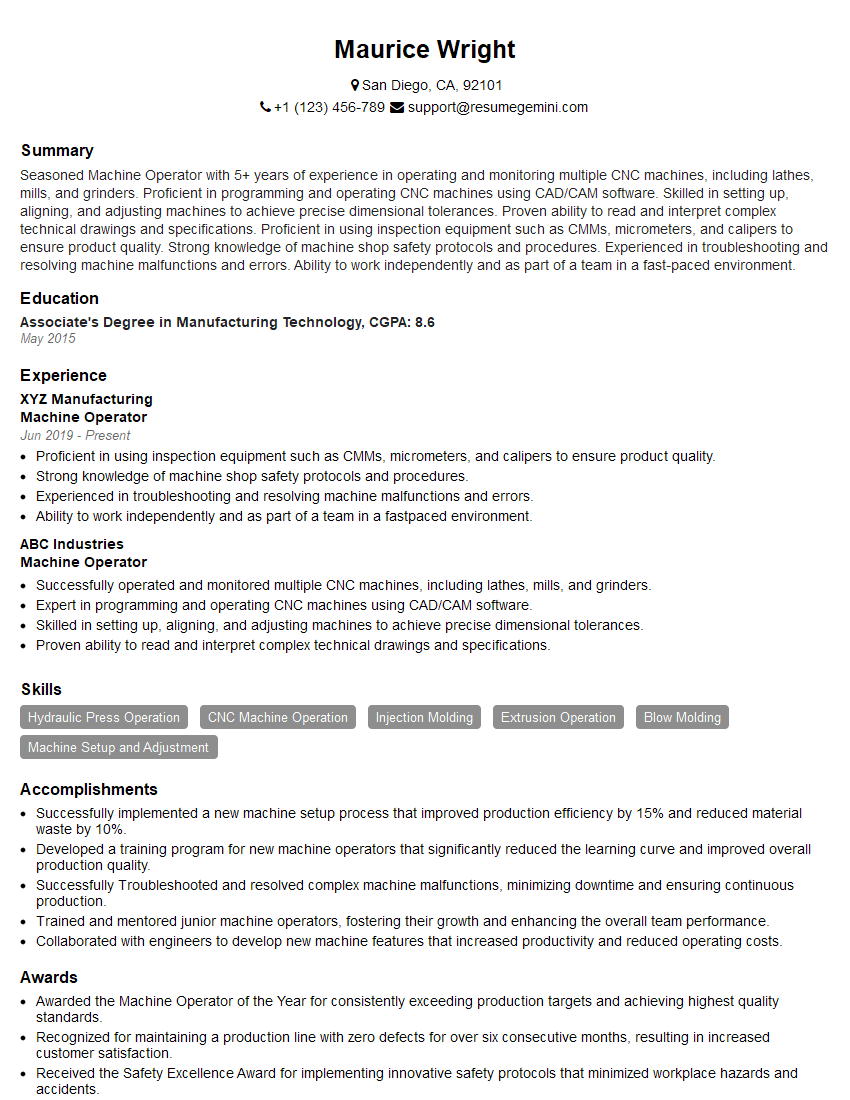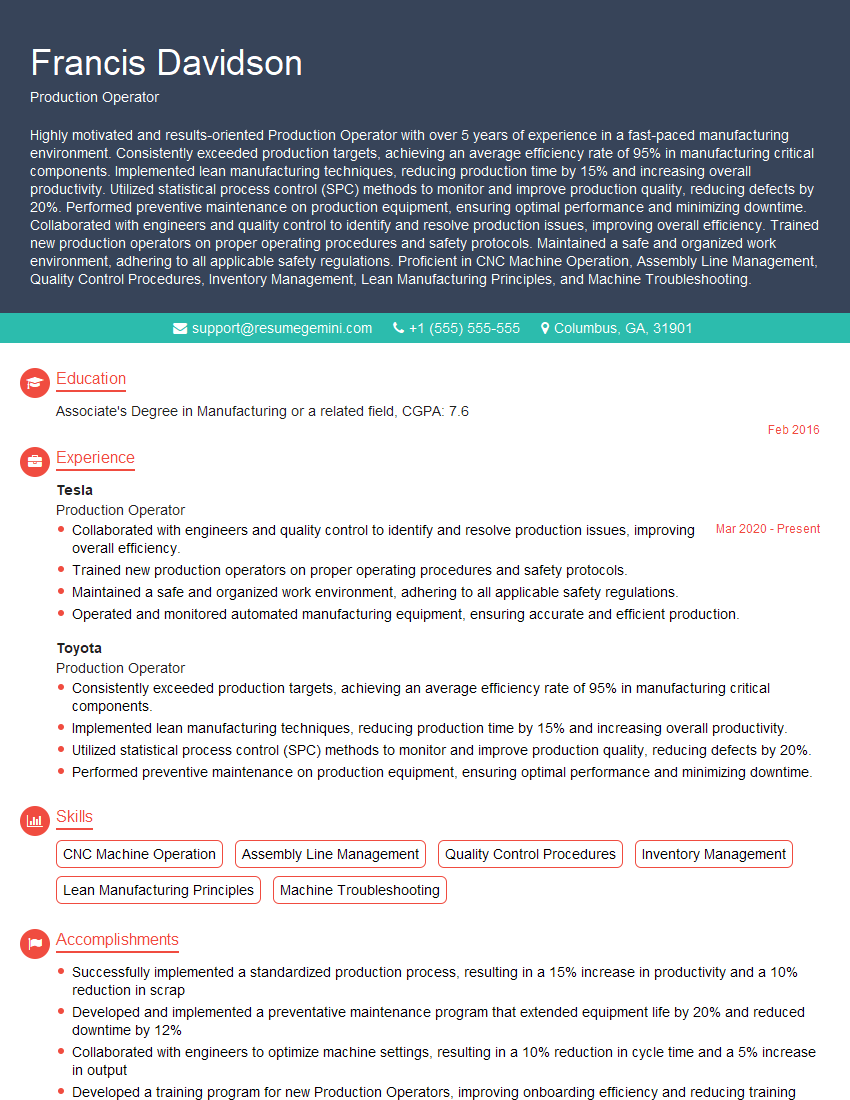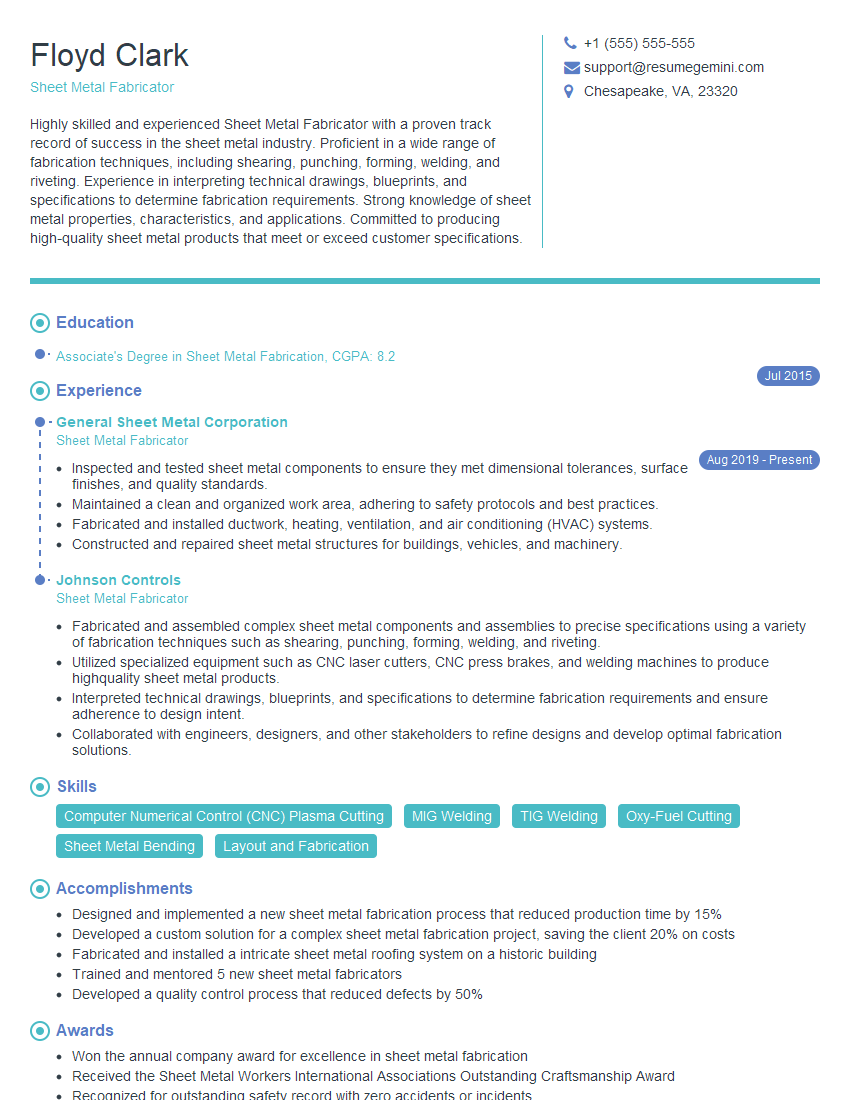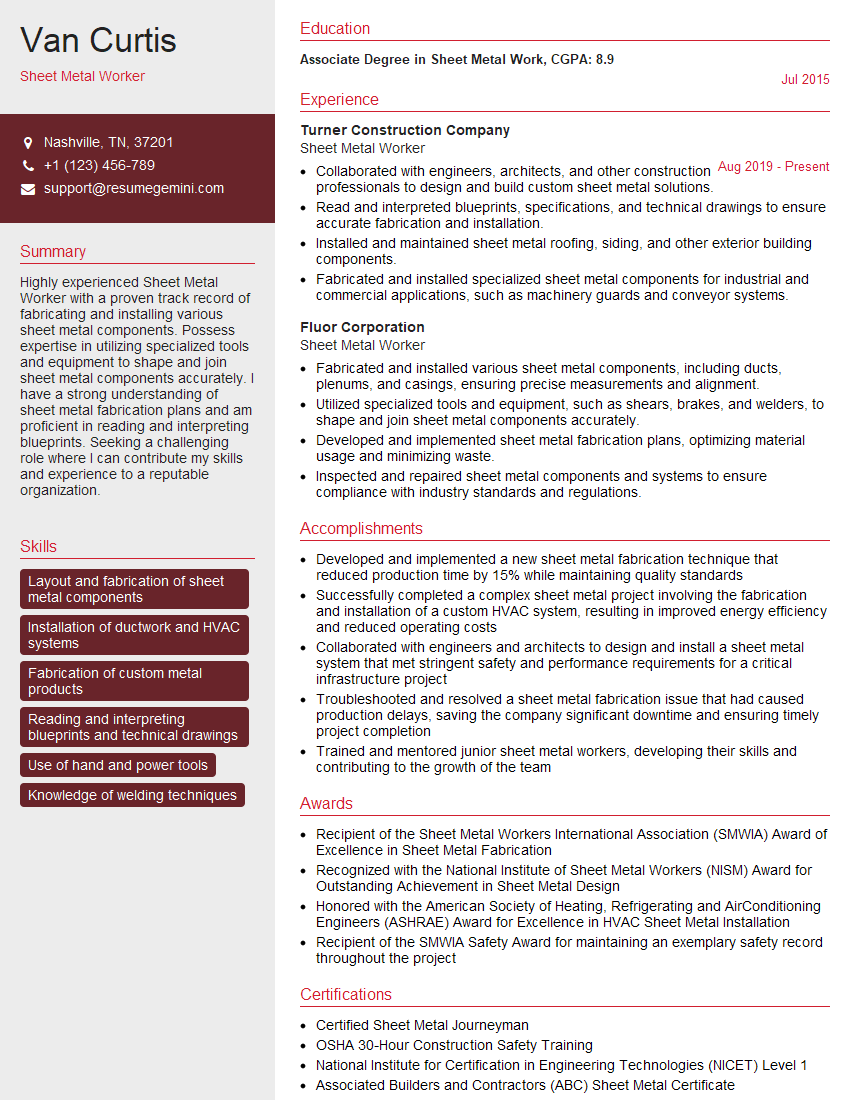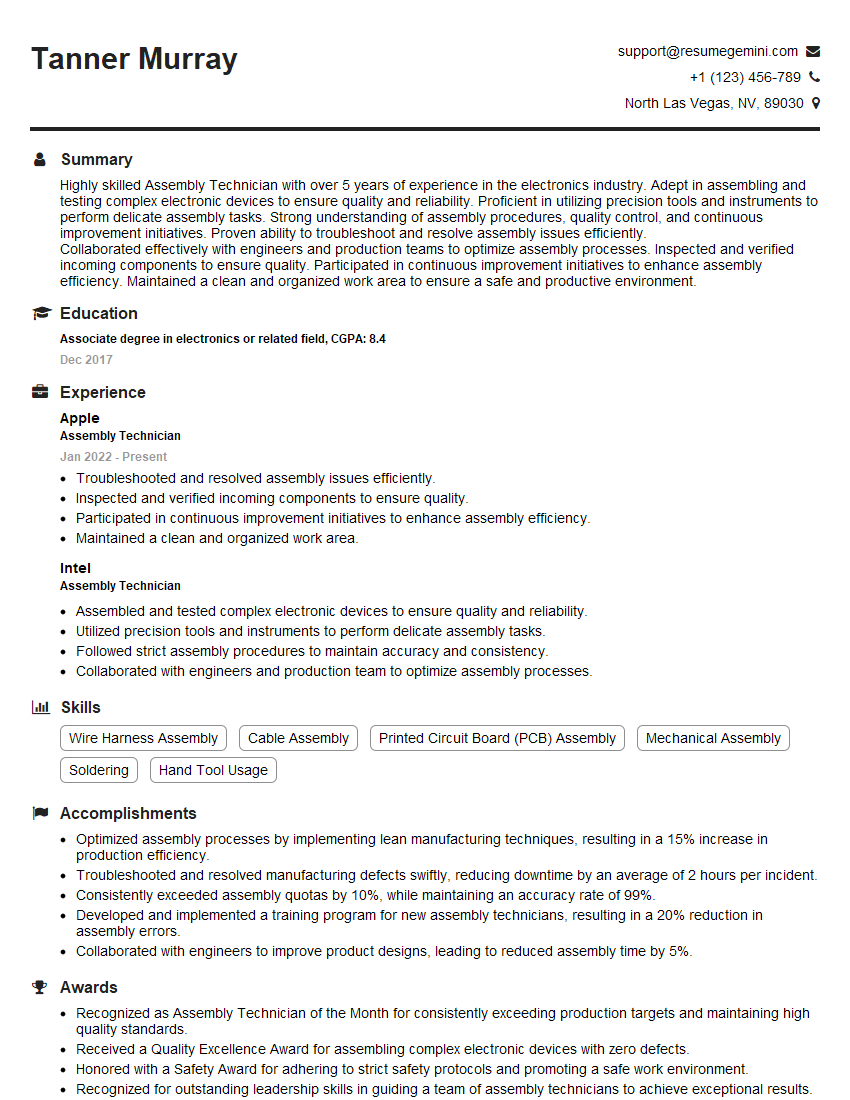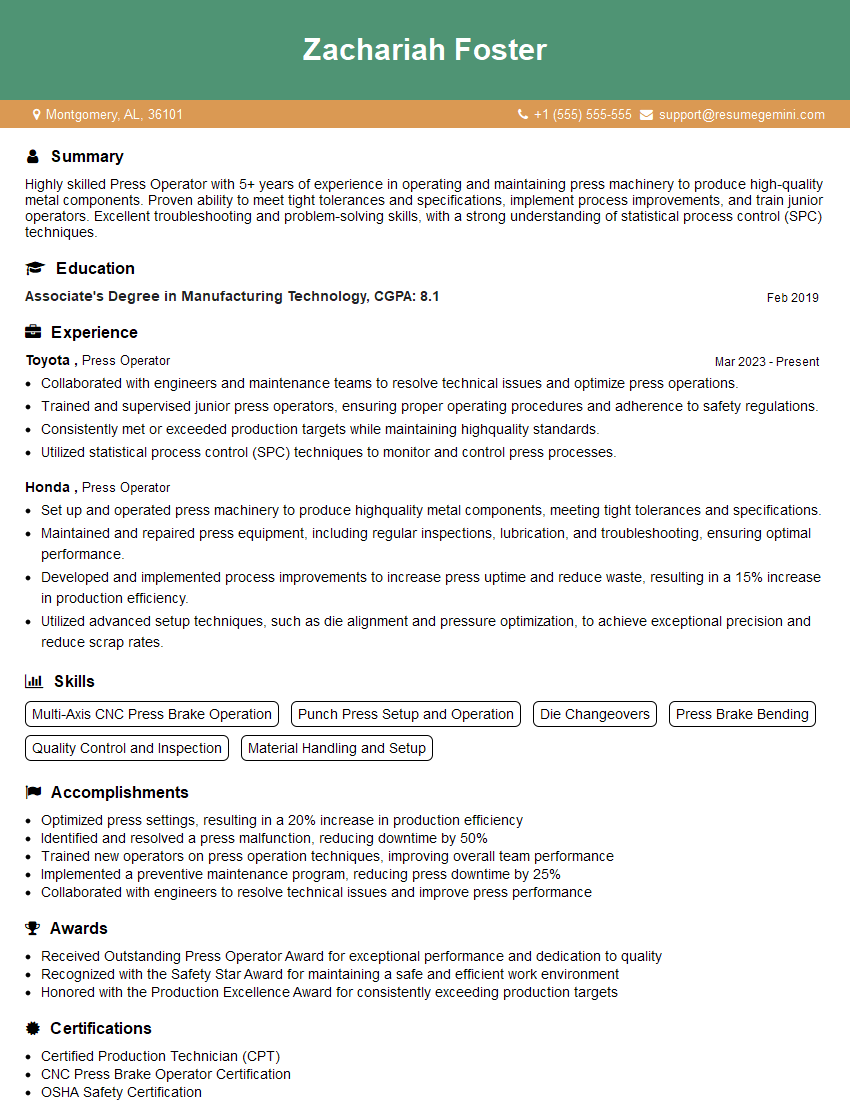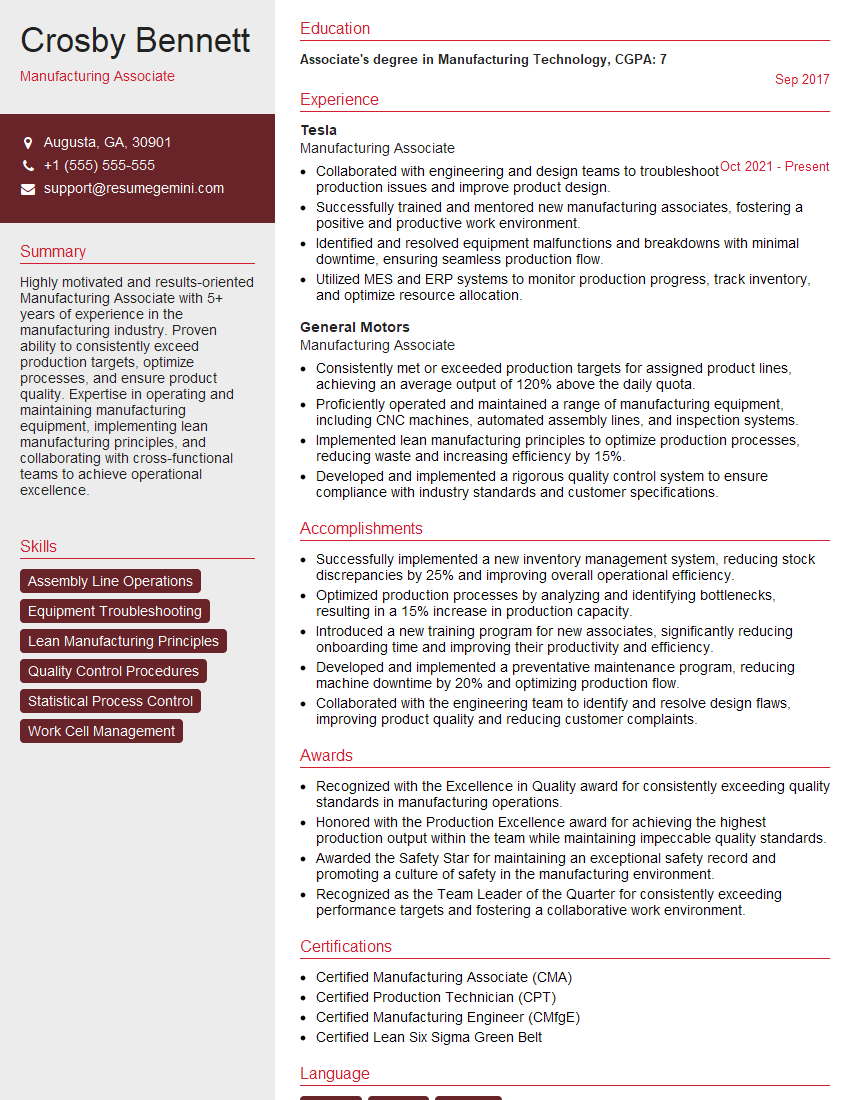Are you ready to stand out in your next interview? Understanding and preparing for Punching Metal Sheets interview questions is a game-changer. In this blog, we’ve compiled key questions and expert advice to help you showcase your skills with confidence and precision. Let’s get started on your journey to acing the interview.
Questions Asked in Punching Metal Sheets Interview
Q 1. Explain the different types of punching presses used in sheet metal fabrication.
Punch presses come in various types, each suited for different production needs and sheet metal thicknesses. The most common types include:
- Mechanical Punch Presses: These use a crankshaft and flywheel to generate the punching force. They are robust, reliable, and relatively simple to maintain, making them ideal for high-volume, repetitive tasks. Think of them as the workhorses of the industry.
- Hydraulic Punch Presses: These utilize hydraulic cylinders to generate the punching force, offering more precise control over the punching pressure and stroke length. They’re particularly useful for thicker materials or complex shapes where consistent force is crucial. Imagine them as the precision instruments of the punching world.
- Pneumatic Punch Presses: These use compressed air to power the punching mechanism. They are typically smaller and lighter than mechanical or hydraulic presses, making them suitable for lighter-duty applications or portable use. Think of them as the nimble, lightweight options.
- CNC Turret Punch Presses: These are computer-controlled machines with multiple tooling stations (turrets) that can perform various punching operations automatically. They’re highly efficient for intricate parts with multiple features, significantly increasing production speed and minimizing human error. Consider these the automation champions.
The choice of press depends heavily on factors like production volume, material thickness, part complexity, and budget.
Q 2. Describe the process of setting up a punch press for a specific job.
Setting up a punch press involves a methodical approach to ensure accuracy, safety, and efficient operation. Here’s a breakdown:
- Die Selection and Installation: Choose the correct die set based on the part design and material (as detailed in the next answer). Carefully mount the die in the press, ensuring it’s securely fastened and aligned correctly.
- Material Preparation: Check the sheet metal for defects. Ensure it’s properly leveled and supported to prevent bending or buckling during punching. Proper clamping is essential to hold the sheet securely in place.
- Press Adjustment: Adjust the press stroke length to match the die height, ensuring the punch fully penetrates the material without causing excessive force or damage. The press should be adjusted for the appropriate tonnage (calculated as explained in question 5).
- Test Run: Perform a test run using a scrap piece of the same material to check the alignment and quality of the punched part. Adjustments are often necessary to refine the process.
- Production Run: Once satisfied with the test run, initiate the full production run, monitoring the process for consistent quality and identifying any potential issues.
Throughout this process, careful attention to detail and adherence to safety protocols are paramount.
Q 3. How do you determine the appropriate die for a given sheet metal punching operation?
Selecting the appropriate die is crucial for successful punching. The key factors to consider are:
- Part Geometry: The die must accurately reflect the shape of the hole or feature you’re punching. This includes the size, shape (round, square, oblong, etc.), and any special features (e.g., louvers).
- Material Thickness: The die must be designed for the specific thickness of the sheet metal. Using a die designed for thinner material on thicker material will lead to breakage. Conversely, using a die for thicker material on thinner material leads to oversized holes and deformation.
- Material Type: Different materials have varying hardness and ductility. The die’s design and material should be selected accordingly. For instance, punching stainless steel requires a more robust die than punching mild steel.
- Punching Force: The die must be capable of withstanding the punching force required to penetrate the material without deformation or failure. This is where shear strength plays a crucial role (as explained further in question 6).
Manufacturers provide detailed specifications for their dies, including the compatible material types and thicknesses. Selecting the incorrect die can lead to costly downtime, part defects, and even equipment damage.
Q 4. What safety precautions must be taken when operating a punch press?
Safety is paramount when operating a punch press. Failure to follow safety procedures can lead to serious injury or even death. Key precautions include:
- Proper Training: Operators must receive thorough training before operating the press. This includes understanding the machine’s controls, safety features, and potential hazards.
- Lockout/Tagout Procedures: Before any maintenance or repair, the press must be properly locked out and tagged out to prevent accidental activation. This is critical to avoid injury during maintenance tasks.
- Personal Protective Equipment (PPE): Operators must wear appropriate PPE, including safety glasses, hearing protection, and gloves. In some cases, specialized protective clothing might be required.
- Machine Guards: Ensure all safety guards are in place and functioning correctly. These guards prevent access to dangerous moving parts.
- No Loose Clothing or Jewelry: Avoid wearing loose clothing or jewelry that could become entangled in moving parts. The press must have a clear working area around it to avoid tripping hazards.
- Emergency Stop Button: Operators must be familiar with the location and operation of the emergency stop button.
Regular maintenance and inspections are also crucial for preventing accidents and ensuring safe operation.
Q 5. How do you calculate the tonnage required for a specific punching operation?
Calculating the required tonnage for a punching operation is crucial to select the right press and prevent equipment damage. A precise calculation requires specialized software and engineering expertise; however, a simplified estimation can be obtained using the following formula:
Tonnage ≈ Shear Strength × Material Thickness × Hole Perimeter
Where:
- Shear Strength: This is a material property, usually found in material data sheets (explained further in question 6).
- Material Thickness: The thickness of the sheet metal being punched (in inches).
- Hole Perimeter: The perimeter of the punched hole (in inches).
This is a simplified approximation, and factors like die geometry, material condition, and lubrication can affect the actual tonnage required. It’s always best to consult engineering resources or utilize specialized software for accurate calculations.
Q 6. Explain the concept of material shear strength and its relevance to punching.
Material shear strength is the amount of force required to shear or cut a material. In punching, it represents the resistance the sheet metal offers to being cut by the punch. The shear strength dictates the force (tonnage) needed to successfully punch a hole. A higher shear strength means more force is required, and vice versa.
This is crucial because if the press doesn’t provide sufficient tonnage, the punch may not cleanly cut the material. This can lead to defects such as:
- Burrs: Uneven edges around the punched hole.
- Fractures: Cracking or breaking of the material around the hole.
- Incomplete Punching: The punch doesn’t fully penetrate the material.
Conversely, excessive tonnage can cause deformation of the material or damage to the die itself. Therefore, accurately determining and applying the correct tonnage, guided by the material’s shear strength, is critical for successful and efficient punching operations.
Q 7. What are the common causes of defects in punched metal sheets?
Several factors can contribute to defects in punched metal sheets. These defects can range from minor imperfections to major flaws rendering the part unusable. Common causes include:
- Improper Die Selection: Using the wrong die for the material thickness or geometry can lead to burrs, fractures, or incomplete punches.
- Insufficient or Excessive Tonnage: Insufficient tonnage results in incomplete punches or burrs, while excessive tonnage can cause material deformation or die damage.
- Poor Material Quality: Defects in the sheet metal, such as surface imperfections or inconsistencies in thickness, can propagate during the punching process, leading to flawed parts.
- Die Wear: Worn dies can lead to inconsistent hole sizes, burrs, and other defects. Regular inspection and replacement are essential.
- Lubrication Issues: Insufficient or improper lubrication can increase friction and lead to burrs, increased wear on the die, and even sticking of the material.
- Misalignment of Die: Misalignment of the die and punch can result in distorted holes or uneven edges.
- Material Work Hardening: Repeated punching of materials can cause work hardening, making subsequent punches more difficult and prone to defects.
Identifying and addressing the root cause of these defects is essential for improving process efficiency and ensuring consistent part quality.
Q 8. How do you identify and troubleshoot common punch press malfunctions?
Troubleshooting punch press malfunctions requires a systematic approach. First, ensure safety by isolating the power source. Then, we systematically examine potential issues, starting with the most likely causes.
Die Problems: Broken punches or dies, misalignment, or worn-out components are frequent culprits. Visual inspection is key; look for cracks, chips, or excessive wear. A simple example: a cracked punch can lead to inconsistent hole sizes or broken parts. Replacing the faulty die is usually the solution.
Mechanical Issues: Problems with the press itself include issues with the ram, crankshaft, or clutch. Unusual noises (grinding, banging) or erratic movements indicate mechanical problems requiring professional attention. For example, a loose crankshaft can lead to inaccurate punching and potential damage to the press.
Material Handling: Incorrect sheet metal feeding can lead to jams, misalignment, or damage to the die. Ensure proper alignment and consistent material feed. A common mistake is feeding the sheet at an angle, resulting in skewed holes or damaged dies.
Lubrication: Insufficient lubrication leads to increased friction, wear, and heat buildup. Regular lubrication is critical; using the correct lubricant is equally important. Ignoring lubrication can drastically reduce die life and even cause press malfunctions.
Electrical Issues: Problems with the control system, sensors, or motor can cause the press to malfunction. A qualified electrician should troubleshoot electrical issues. For example, a faulty limit switch might prevent the press from completing a cycle properly.
Often, a combination of these factors contributes to a malfunction. Careful observation, coupled with a knowledge of the punch press’s operation, is crucial for effective troubleshooting.
Q 9. Describe different types of punch press dies and their applications.
Punch press dies come in various types, each designed for specific applications. The choice of die depends on the shape, size, and material of the sheet metal being punched.
Billet Dies: These are simple dies used for punching round holes. They’re cost-effective for high-volume production of round holes.
Progressive Dies: These dies perform multiple operations in a single stroke. This significantly increases production speed and efficiency. Imagine a single press stroke punching a hole, then forming a tab—all in one operation.
Compound Dies: These dies perform two or more operations simultaneously, but unlike progressive dies, they don’t require multiple stages within a single stroke. A common example is punching a hole and simultaneously notching the sheet metal.
Blanking Dies: These are designed for cutting out shapes from the sheet metal, creating a blank for subsequent processing. Think of making a rectangular component from a sheet of metal – a blanking die performs that initial cut.
Piercing Dies: Used for creating holes in sheet metal. Often used alongside blanking dies in more complex processes.
Forming Dies: These go beyond punching holes; they create bends, curves, or other shapes in the metal. This enables the creation of more complex parts in a single process.
The selection of a specific die type is based on factors like the complexity of the part, production volume, material thickness, and desired accuracy.
Q 10. Explain the importance of proper lubrication in punch press operation.
Proper lubrication in punch press operation is critical for several reasons. It’s the lifeblood of efficient and long-lasting operation.
Reduced Friction: Lubricants minimize friction between moving parts, reducing wear and tear on the die and the press itself. This translates to extended die life and less maintenance.
Improved Accuracy: Reduced friction ensures smoother operation, leading to more accurate punching and better-quality parts. Inconsistent lubrication can lead to inconsistent hole sizes or even damaged parts.
Heat Reduction: Friction generates heat, which can damage the die and even lead to safety hazards. Lubricants help dissipate this heat, preventing overheating and potential damage.
Increased Productivity: Smooth operation means faster production rates and less downtime due to malfunctions.
Safety: Reduced friction and heat lead to a safer working environment.
The choice of lubricant depends on the specific application, material being processed, and the type of press. Using the wrong lubricant can be counterproductive and even lead to equipment damage.
Q 11. How do you measure the accuracy of punched holes?
Measuring the accuracy of punched holes involves several techniques depending on the required precision. Simple checks can be performed using basic measuring tools, while more rigorous methods involve sophisticated equipment.
Caliper or Micrometer: These are used to measure the diameter of round holes. Accuracy depends on the quality of the tools and the skill of the operator.
Optical Comparator: This provides a magnified view of the punched part, allowing for accurate measurement of hole dimensions and location. It’s especially useful for complex shapes.
Coordinate Measuring Machine (CMM): For extremely high precision, a CMM is used. It provides highly accurate measurements of hole location and dimensions in three dimensions.
The chosen method depends on the tolerances required and the complexity of the punched part. Each measurement should be documented for quality control purposes.
Q 12. What are the different types of sheet metal materials commonly punched?
A wide range of sheet metal materials is commonly punched, each with its unique properties affecting the punching process.
Mild Steel: A common and relatively easy-to-punch material. It’s widely used for various applications.
Stainless Steel: More difficult to punch than mild steel due to its higher strength and work hardening. Special tooling and techniques are often required.
Aluminum: Relatively easy to punch but can be prone to deformation if not handled carefully.
Brass: Relatively soft and easy to punch, often used for decorative or electrical applications.
Copper: Similar to brass in terms of punching ease.
Zinc: Relatively soft and ductile, but can require specific tooling due to its tendency to deform easily.
Material selection is crucial, as it impacts die life, punching force, and the overall quality of the final product. The material’s thickness also plays a significant role in determining the appropriate punching parameters.
Q 13. How do you select the appropriate punch press speed for a given material and die?
Selecting the appropriate punch press speed depends on several factors. Too fast, and the risk of die damage or broken parts increases; too slow, and productivity suffers.
Material Properties: Harder and thicker materials require slower speeds to prevent damage. Softer, thinner materials can tolerate higher speeds.
Die Design: Complex dies often require slower speeds for accurate punching. Simpler dies can handle higher speeds.
Punch Press Capacity: The press’s rated capacity limits the maximum speed for a given material and die. Exceeding the capacity risks press damage.
Desired Quality: Higher quality requirements often necessitate slower speeds for better accuracy and surface finish.
Manufacturers provide guidelines for optimal speeds for specific materials and die types. Careful consideration of these factors prevents excessive wear, extends die life, and ensures the production of high-quality parts. Trial runs often help fine-tune the speed for best results.
Q 14. Explain the role of strippers in a punching operation.
Strippers are crucial components in punching operations. Their primary function is to remove the punched part from the die after the punching operation is complete. Without strippers, the punched part might stick to the punch or die, causing damage and downtime.
Types of Strippers: There are various types, including spring-loaded strippers, air-operated strippers, and mechanical strippers. The choice depends on factors like material thickness, part geometry, and production volume.
Function: Strippers prevent sticking by applying a controlled upward force on the sheet metal after the punch has completed its stroke. This action cleanly separates the punched part from the die.
Importance: Effective stripping is crucial for ensuring smooth operation, preventing die damage, maintaining part quality, and increasing overall productivity. Improper stripping can lead to production delays, part damage, or even serious equipment malfunctions.
Imagine trying to remove a cookie from a cookie cutter without a spatula—it’s messy and inefficient. Strippers perform the same function, ensuring clean removal of punched parts.
Q 15. Describe the process of maintaining and cleaning punch press dies.
Maintaining and cleaning punch press dies is crucial for ensuring consistent part quality, extending die life, and preventing costly downtime. Think of it like regularly servicing your car – neglecting it leads to bigger problems later.
Regular Inspection: After each run, visually inspect the die for wear, damage (cracks, chips), or build-up of material. Look closely at the punch and die surfaces for signs of wear or deformation.
Cleaning: Use appropriate cleaning agents and tools to remove debris, swarf (metal shavings), and lubricants. Compressed air is often used for initial cleaning, followed by a brush for more stubborn material. Avoid harsh chemicals that might damage the die material.
Sharpening/Resharpening: Depending on the wear, punches and dies might require sharpening or resharpening using specialized grinding equipment. This requires expertise and precision to maintain the correct geometry.
Lubrication: Proper lubrication is vital to reduce friction and wear. The type of lubricant depends on the material being punched and the die material. Over-lubrication can be as harmful as under-lubrication, leading to build-up of material.
Storage: When not in use, dies should be stored in a clean, dry environment to prevent rust and corrosion. Protecting them with a light coating of oil can further prevent degradation.
Example: During a recent job punching stainless steel, we noticed slight burring on the edges of the parts. A close inspection of the die revealed slight wear on the punch. We resharpened the punch and the burring problem was immediately resolved, illustrating the importance of regular maintenance.
Career Expert Tips:
- Ace those interviews! Prepare effectively by reviewing the Top 50 Most Common Interview Questions on ResumeGemini.
- Navigate your job search with confidence! Explore a wide range of Career Tips on ResumeGemini. Learn about common challenges and recommendations to overcome them.
- Craft the perfect resume! Master the Art of Resume Writing with ResumeGemini’s guide. Showcase your unique qualifications and achievements effectively.
- Don’t miss out on holiday savings! Build your dream resume with ResumeGemini’s ATS optimized templates.
Q 16. How do you handle different sheet metal thicknesses in a punching operation?
Handling different sheet metal thicknesses in punching requires adjustments to the punch press setup and, in some cases, the dies themselves. It’s like adjusting the pressure on a nail gun – more pressure is needed for thicker wood.
Punch Press Adjustment: Thicker materials necessitate adjustments to the press’s tonnage (force) to ensure complete penetration without damaging the die or the press itself. Higher tonnage settings are required for thicker sheets.
Die Selection: In some cases, different dies are needed for different thicknesses. A die designed for thin sheet metal might not withstand the pressures involved in punching thick sheets. The punch and die materials themselves might even need to be changed to handle the increased force.
Feed Rate: The speed at which the sheet metal is fed into the press must be adjusted. Slower speeds are often necessary for thicker materials to ensure accurate and clean punching.
Lubrication: Proper lubrication is particularly crucial for thicker materials due to increased friction.
Example: When switching from 0.0625” aluminum to 0.125” aluminum sheets, we increased the press tonnage by 20% and slowed down the feed rate by approximately 15% to maintain part quality and avoid die damage.
Q 17. What are the different methods for feeding sheet metal into a punch press?
Several methods exist for feeding sheet metal into a punch press, each with its advantages and disadvantages. Choosing the right method depends on factors like sheet metal thickness, material type, and production volume.
Manual Feeding: A simple method suitable for low-volume production. An operator manually places and aligns the sheet metal for each punch.
Automatic Sheet Feeders: These are mechanical devices that automatically feed sheets into the press, significantly increasing production speed and efficiency. They usually have pile feeders, which stack sheets, and a gripper or rollers for feeding.
Roll Feeds: Ideal for high-volume production of long strips of material, roll feeds continuously uncoil and feed the metal. They provide excellent control and precise alignment.
Automated Guided Vehicles (AGV): For high-throughput operations, AGVs can transport stacks of sheet metal to the punch press.
Example: For high-volume production of automotive parts, we utilize roll feeds for continuous operation and high precision.
Q 18. Explain the concept of progressive dies and their advantages.
Progressive dies are specialized tools that perform multiple operations on a single sheet metal blank in one press stroke. Think of it as a miniature assembly line built into the die.
Concept: Progressive dies incorporate multiple punch and die stations arranged sequentially. As the sheet moves through the die, each station performs a specific operation (punching, forming, embossing, etc.), creating a complete part in a single cycle.
Advantages:
- Increased Productivity: Higher production rates compared to using separate dies for each operation.
- Reduced Labor: Less manual handling and less time spent in transferring parts.
- Improved Accuracy: Parts are more consistent and precise due to the automated process.
- Lower Cost per Part: Although the initial die cost is high, the cost per part is significantly reduced for large runs.
Example: In a recent project manufacturing a complex automotive bracket, using a progressive die allowed us to produce thousands of parts daily, compared to the much lower output we would’ve achieved with multiple single-operation dies. This significantly reduced lead times and production costs.
Q 19. How do you ensure the quality and consistency of punched parts?
Ensuring quality and consistency of punched parts requires attention to various factors throughout the entire process.
Die Maintenance: Regular inspection and maintenance of the dies are critical. A worn or damaged die will produce inconsistent parts.
Material Selection and Handling: Using the correct material, consistently storing, and feeding the material is essential for precise punching. Any variability in the metal’s properties will affect the final product.
Press Calibration and Monitoring: Regular calibration of the press and monitoring of tonnage and speed ensure consistent punching force and prevent damage to the parts or die. Digital pressure and stroke monitoring provides accurate data for evaluating the process.
Regular Part Inspection: Consistent inspection – including dimensional checks, visual inspection for burrs or defects, and sometimes destructive testing – helps in maintaining quality and identifying problems early.
Statistical Process Control (SPC): Implementing SPC techniques helps monitor the process and identify sources of variation before they lead to significant quality issues.
Example: We utilize a Coordinate Measuring Machine (CMM) for precise dimensional measurements of our punched parts, helping to verify the accuracy of the process and identifying any deviations from the specifications.
Q 20. Describe your experience with different types of punch press controls (e.g., PLC, CNC).
I have extensive experience with both PLC (Programmable Logic Controller) and CNC (Computer Numerical Control) systems in punch press operations. Both offer automated control but with distinct advantages.
PLC Controls: PLCs are widely used for simpler punch presses, automating tasks like feed rate, tonnage, and press cycle. They are cost-effective and robust, particularly in environments with minimal programming requirements. Often seen in legacy systems or simpler tooling operations.
CNC Controls: CNC controls are more sophisticated and suitable for complex parts and progressive dies. They allow for precise control of every aspect of the punching process, including punch position, speed, and force. This precision is critical for complex shapes and high-volume production. It’s ideal for more advanced tooling like turret punches.
Example: In one project, we used a PLC-controlled press for simple blanking operations, while for another project creating intricately shaped automotive components, a CNC-controlled turret punch press was crucial for the precision and automation needed. I am proficient in programming and troubleshooting both systems.
Q 21. How do you interpret engineering drawings and specifications for punching operations?
Interpreting engineering drawings and specifications for punching operations is fundamental to my role. It’s like reading a recipe – you need to understand all the components and instructions to create the final product.
Dimensional Tolerances: Closely examine the drawing for dimensional tolerances. This dictates the allowable deviation from the specified dimensions and is crucial for the die design and machine setup. Tolerances are critical, and it’s not just about sizes, but also tolerances on angles, parallelism and flatness.
Material Specifications: Identifying the material type, thickness, and surface finish is critical in selecting the correct dies and press settings.
Hole Sizes, Shapes, and Locations: Precisely locating holes, determining their shapes (round, square, etc.), and understanding the required tolerances is critical for programming the punch press or designing the dies.
Bend and Form Details: If the part involves bending or forming, the drawings should specify bend radii, angles, and other relevant parameters.
Surface Finish Requirements: The drawing might specify the desired surface finish, influencing the choice of dies and lubrication strategies.
Example: A recent drawing specified a 0.030” tolerance on a critical hole diameter. I ensured this tolerance was met by utilizing high-precision dies and meticulous press setup. This helped prevent issues and ensure parts met the project requirements.
Q 22. What is your experience with various die materials and their properties?
Die material selection is crucial in punching metal sheets, as it directly impacts the lifespan of the tooling, the quality of the punched parts, and the overall production efficiency. My experience encompasses a wide range of materials, each with its own strengths and weaknesses.
- Tool Steel: This is a workhorse in the industry, offering excellent wear resistance and high hardness. Different grades, like high-speed steel (HSS) and various tool steels (e.g., D2, A2) offer varying degrees of toughness and hardness, making them suitable for different applications and sheet thicknesses. For example, I’ve successfully used D2 tool steel for punching high-strength stainless steel sheets due to its excellent wear resistance and ability to withstand high impact forces.
- Powder Metallurgy Dies: These dies offer exceptional dimensional accuracy and surface finish, ideal for intricate parts requiring tight tolerances. They’re also known for their long lifespan, especially when punching softer metals. I’ve used them extensively in applications where consistency and precision are paramount, such as electronics components.
- Carbide Dies: These are extremely hard and durable, making them ideal for high-volume production runs of harder materials like titanium or hardened steel. The higher initial cost is often offset by their extended service life. I recall a project where carbide dies significantly reduced downtime and tool changes compared to traditional tool steel for punching hardened steel.
- Ceramics: While less common, ceramic dies are used for very specific applications, offering even greater wear resistance than carbide. They are often used for punching abrasive materials.
Choosing the right die material requires careful consideration of factors like the sheet metal’s material, thickness, and hardness, as well as the required production volume and part tolerance.
Q 23. How do you address burrs and other imperfections in punched parts?
Burrs and other imperfections in punched parts are common challenges. Addressing them effectively is key to ensuring part quality and functionality. My approach is multi-faceted, focusing on prevention and remediation.
- Die Design Optimization: Proper die design is paramount. Sharp, well-maintained punches and dies significantly minimize burr formation. For instance, using a specialized punch design to create a shearing action rather than a purely compressive one can greatly reduce burrs.
- Lubrication: Adequate lubrication between the sheet metal and the die significantly reduces friction, leading to smoother punching and reduced burr formation. The right lubricant for the metal being punched is essential.
- Deburring Processes: When burrs are unavoidable, several techniques can remove them. These include:
- Mechanical Deburring: Using brushes, tumbling, or hand tools to remove burrs. This is a cost-effective approach for many applications.
- Chemical Deburring: Using chemical solutions to etch away burrs. This is efficient for delicate or intricate parts.
- Electrochemical Deburring: A more precise method involving electrochemical reactions to remove burrs. This is typically used for high-precision components.
- Quality Control: Regular inspection of punched parts ensures that imperfections are identified and addressed promptly, preventing defects from accumulating.
The choice of deburring method depends on the size and complexity of the parts, the material, and the acceptable level of surface finish.
Q 24. Explain your experience with different types of punch press safety mechanisms.
Safety is paramount in punch press operations. My experience includes working with a variety of safety mechanisms designed to prevent accidents.
- Light Curtains: These are non-contact sensors that detect the presence of an operator’s hand or any other object in the press’s danger zone, instantly stopping the machine. These are essential for many applications and are often paired with other safety measures.
- Two-Hand Controls: These require the operator to simultaneously activate two controls to initiate the press stroke, ensuring both hands are safely away from the danger zone. They are a simple yet effective method.
- Safety Guards: Physical barriers that prevent access to the press’s moving parts. These provide an added level of protection and can be designed for specific applications.
- Emergency Stop Buttons: Strategically placed buttons that immediately halt the press operation in emergency situations. These should be easily accessible and clearly visible.
- Die Cushions: These help to absorb the impact during the punching process, preventing damage to the press or the workpiece. They are critical for minimizing shock and improving the safety and quality of the operation.
Implementing a layered safety approach, combining several mechanisms, offers the highest level of protection. Regular inspections and maintenance of these safety systems are crucial for ensuring their effectiveness.
Q 25. How do you calculate the production rate for a given punching operation?
Calculating the production rate for a punching operation involves several factors. It’s not just about the press’s speed; it accounts for all aspects of the operation.
The formula is generally:
Production Rate (parts/hour) = (Press Speed (strokes/min) * 60 min/hour * Number of Parts per Stroke) / (1 + (Downtime Ratio))Where:
- Press Speed: The rated speed of the punch press in strokes per minute. This is often specified by the manufacturer.
- Number of Parts per Stroke: This depends on the die design. A single die might produce one part per stroke, while a progressive die can produce multiple parts.
- Downtime Ratio: Accounts for factors like die changes, material handling, and machine maintenance. This is often expressed as a percentage or decimal representing the proportion of time the machine is not actively producing parts (e.g., 0.10 for 10% downtime).
Example: A press with a speed of 100 strokes/minute, producing one part per stroke, and having 10% downtime would have a production rate of approximately 5400 parts/hour (100 * 60 * 1 / (1 + 0.10)).
Accurate estimation requires careful consideration of all these variables and accurate measurement of downtime.
Q 26. Describe your experience with preventive maintenance of punch presses.
Preventive maintenance (PM) is vital for maintaining the longevity and efficiency of punch presses. It involves a structured approach to identifying and addressing potential issues before they lead to breakdowns. My experience with PM involves:
- Regular Inspections: Visual inspections, checking for wear and tear on components like punches, dies, and guide pins. Checking for lubrication levels and oil leaks.
- Lubrication: Regular lubrication of moving parts is crucial to reduce friction and extend component lifespan. I follow the manufacturer’s recommended lubrication schedule for all critical parts.
- Cleaning: Regular cleaning of the press, removing chips and debris, is essential for maintaining efficiency and preventing damage. I use air blowers and appropriate cleaning solvents.
- Calibration: Periodic calibration of the press ensures it’s operating within its specified tolerances. Misaligned components can affect part quality and machine life.
- Scheduled Maintenance: Following a planned schedule for more extensive maintenance tasks, such as replacing worn-out parts or performing electrical inspections. I maintain detailed maintenance logs to track all work performed.
Implementing a robust PM program minimizes downtime, reduces repair costs, and extends the lifespan of the press, ultimately enhancing productivity and safety.
Q 27. What software or systems are you familiar with for managing punch press operations?
Managing punch press operations effectively requires utilizing appropriate software and systems. My experience includes working with:
- Computer Numerical Control (CNC) systems: These are used to automate the operation of the punch press, enabling complex part geometries and precise control. I’m proficient in programming and operating various CNC systems, ensuring efficient and accurate production.
- Manufacturing Execution Systems (MES): These software solutions help in tracking and managing the entire production process, from scheduling and material management to quality control and inventory management. I have experience using MES to optimize production flow and reduce waste.
- Computer-Aided Design (CAD) and Computer-Aided Manufacturing (CAM) software: I use CAD software to design dies and tooling and CAM software to generate CNC programs, optimizing the entire process from design to production.
- Production Monitoring Systems: These systems provide real-time data on machine performance, helping identify potential problems and optimize production parameters. I use such data to identify bottlenecks and make improvements.
Leveraging these technologies enables efficient planning, execution, and optimization of punch press operations.
Q 28. Describe a time you had to troubleshoot a complex problem with a punch press.
I once encountered a situation where a high-speed progressive die was producing parts with inconsistent dimensions. Initial troubleshooting steps, like checking lubrication and die alignment, yielded no results. The problem was intermittent and difficult to pinpoint.
My systematic approach involved:
- Detailed Analysis of the Problem: I carefully analyzed the defective parts, noting the specific inconsistencies and when they occurred during the production cycle.
- Data Acquisition: Using the production monitoring system, I gathered detailed data on the press’s operational parameters during the production run, specifically focusing on the timing of the defects.
- Hypothesis Testing: Based on the data, I hypothesized that the issue might be related to wear or damage in a specific section of the progressive die. I suspected a subtle issue with a critical punch or die component.
- Targeted Inspection: A thorough inspection of the suspected section of the die under a microscope revealed microscopic cracks in one of the critical punches. This was only visible under magnification.
- Resolution: Replacing the damaged punch resolved the inconsistency problem. We also implemented more frequent inspections to catch such issues earlier.
This experience highlighted the importance of a systematic approach, data-driven analysis, and thorough inspection in troubleshooting complex problems in punch press operations.
Key Topics to Learn for Punching Metal Sheets Interview
- Metal Sheet Properties: Understanding different metal types (steel, aluminum, etc.), their thicknesses, and their impact on punching processes. This includes knowing yield strength, tensile strength, and ductility.
- Punching Press Operation: Familiarize yourself with the mechanics of a punching press, including die and punch selection, tonnage requirements, and safety procedures. Consider the differences between various press types.
- Die Design and Selection: Learn about different die designs and how to select the appropriate die for various shapes and sizes of holes. Understand factors influencing die life and maintenance.
- Tooling and Maintenance: Gain knowledge on proper tooling maintenance, including lubrication, sharpening, and replacement. Understand how to identify wear and tear and potential issues.
- Material Handling and Storage: Learn about safe and efficient methods for handling and storing metal sheets, minimizing waste and damage.
- Quality Control and Inspection: Understand quality control measures used in punching metal sheets, including dimensional accuracy, burr control, and surface finish inspection. Know relevant quality standards.
- Troubleshooting and Problem Solving: Develop your ability to identify and resolve common problems encountered during the punching process, such as die breakage, material defects, and dimensional inaccuracies.
- Safety Regulations and Practices: Thoroughly understand all safety regulations and best practices related to operating punching presses and handling metal sheets.
- Production Processes and Optimization: Understand how punching integrates into broader manufacturing processes and strategies for optimizing efficiency and minimizing downtime.
Next Steps
Mastering the art of punching metal sheets opens doors to diverse and rewarding career opportunities in manufacturing and related industries. A strong understanding of this process demonstrates valuable technical skills and problem-solving abilities highly sought after by employers. To significantly enhance your job prospects, it’s crucial to present your skills effectively through a well-crafted, ATS-friendly resume. ResumeGemini is a trusted resource that can help you build a professional resume tailored to highlight your expertise in punching metal sheets. Examples of resumes specifically designed for this field are available to guide you. Take the next step and create a resume that truly showcases your potential!
Explore more articles
Users Rating of Our Blogs
Share Your Experience
We value your feedback! Please rate our content and share your thoughts (optional).
What Readers Say About Our Blog
Hello,
We found issues with your domain’s email setup that may be sending your messages to spam or blocking them completely. InboxShield Mini shows you how to fix it in minutes — no tech skills required.
Scan your domain now for details: https://inboxshield-mini.com/
— Adam @ InboxShield Mini
Reply STOP to unsubscribe
Hi, are you owner of interviewgemini.com? What if I told you I could help you find extra time in your schedule, reconnect with leads you didn’t even realize you missed, and bring in more “I want to work with you” conversations, without increasing your ad spend or hiring a full-time employee?
All with a flexible, budget-friendly service that could easily pay for itself. Sounds good?
Would it be nice to jump on a quick 10-minute call so I can show you exactly how we make this work?
Best,
Hapei
Marketing Director
Hey, I know you’re the owner of interviewgemini.com. I’ll be quick.
Fundraising for your business is tough and time-consuming. We make it easier by guaranteeing two private investor meetings each month, for six months. No demos, no pitch events – just direct introductions to active investors matched to your startup.
If youR17;re raising, this could help you build real momentum. Want me to send more info?
Hi, I represent an SEO company that specialises in getting you AI citations and higher rankings on Google. I’d like to offer you a 100% free SEO audit for your website. Would you be interested?
Hi, I represent an SEO company that specialises in getting you AI citations and higher rankings on Google. I’d like to offer you a 100% free SEO audit for your website. Would you be interested?
good






